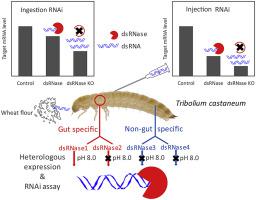Insect Biochemistry and Molecular Biology ( IF 3.8 ) Pub Date : 2020-08-06 , DOI: 10.1016/j.ibmb.2020.103440 Yingchuan Peng 1 , Kangxu Wang 2 , Jiasheng Chen 2 , Jinda Wang 2 , Hainan Zhang 2 , Longji Ze 2 , Guanheng Zhu 3 , Chunqing Zhao 2 , Haijun Xiao 1 , Zhaojun Han 2

|
RNA interference (RNAi) efficiency dramatically varies among different insects and among administration methods. Numerous studies have revealed that a poor RNAi response is usually associated with a high double-stranded RNA (dsRNA)-degrading activity. Using the red flour beetle Tribolium castaneum, we conducted genome-wide identification of genes encoding dsRNA-degrading nucleases of the DNA/RNA non-specific endonuclease superfamily. To achieve a robust RNAi response in T. castaneum, four dsRNase genes were identified in the genome that seemed to be the potential factors reducing RNAi efficacy. Analysis of biochemical properties revealed that optimal conditions for the dsRNA-degrading activity were alkaline (pH 8.0) in the absence of Mg2+ at 37 °C. The dsRNA-degrading activity was predominantly present in the gut, and via heterologous expression and RNAi experimentation, gut-specific TcdsRNase1 was confirmed as the major nuclease performing dsRNA degradation. After a knockdown of the TcdsRNase1 nuclease activity, RNAi efficiency improved from 38.6% to 58.9% and from 20.9% to 53.9% for injection and ingestion of dsRNA, respectively. Our results contribute to a comprehensive understanding of the mechanisms influencing dsRNA stability and even RNAi efficiency in T. castaneum and point to a good method for improving RNAi efficiency through downregulation of the relevant nuclease activity.
中文翻译:

识别影响食用小麦和注射小麦的红色链甲虫Tribolium castaneum的双链RNA降解核酸酶。
RNA干扰(RNAi)的效率在不同的昆虫之间和给药方法之间差异很大。大量研究表明,较差的RNAi反应通常与较高的双链RNA(dsRNA)降解活性有关。我们使用红色的甲虫Tribolium castaneum,对DNA / RNA非特异性核酸内切酶超家族的dsRNA降解核酸酶进行编码的基因进行了全基因组鉴定。为了在栗树中获得强大的RNAi反应,在基因组中鉴定了四个dsRNase基因,这似乎是降低RNAi功效的潜在因素。生化特性分析表明,在不存在Mg 2+的情况下,dsRNA降解活性的最佳条件是碱性(pH 8.0)在37°C下。dsRNA降解活性主要存在于肠道中,通过异源表达和RNAi实验,证实肠道特异性TcdsRNase1是执行dsRNA降解的主要核酸酶。敲低TcdsRNase1核酸酶活性后,注射和摄入dsRNA的RNAi效率分别从38.6%提高到58.9%,从20.9%提高到53.9%。我们的研究结果有助于在影响dsRNA的稳定,甚至效率的RNAi机制的全面了解赤拟谷盗,并指向一个很好的方法,通过相关核酸酶活性的下调提高效率的RNAi。



























 京公网安备 11010802027423号
京公网安备 11010802027423号